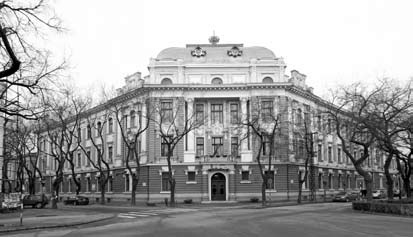The building of the old gymnasium in Subotica was built in 1817, but the City Senate in 1895 decided to build a new building, according to Ferenc Rajhla’s projects, and the construction contractor was Karolj Molcer. Construction began in 1896, and the building was finally handed over to use in 1900. This imposing object was created by Rajhl in the spirit of the late Baroque, which he consistently applied in decorating the interior.
The building is two-storey, located at the corner of the streets of Petefi Sandor and Felgius, so that two branches of the building are provided from the diagonally sloping facade, giving the basis of the incorrect Latin letter “V”. The complete architectural concept is subordinate to the applicable Baroque laws. On street facades, decorative plastic is concentrated around the apertures in the form of floral and geometric motifs on the floors, as well as on the diagonally sloping procheon rizalit, which is multiplied along the side wings of the building. The ground belt of the whole building is rustically processed, and the verticalism of the work is emphasized by two massive Corinthian pillars, circular bases stretching along both floors. The procheon corpus itself is rounded up and raised and dome is covered with tin plates, and at its very top are two seated figures supporting the globe in the middle.The dome is set on a high, flat façade with arched window openings in a row. The splendid impression of a prominent facade contributes to the ground floor of the main entrance portal which introduces us into a representative part of the building. As a crown decoration of this corpus, it is certainly a sculptor’s decoration of the figure of a young man in a natural size in a standing position, with hands resting on the Baroque lines of volumes made in plaster. The baroque representativity of the edge rhizalites is achieved by marginal solid pilasters, sharp profiles along both floors with a glossy capitol, in full plastic with the head of Satire – grotesque in the web of floral decoration. Risalites are decorated as a whole and accentuated by flat attacks with pilasters and openings. The windows on the side wings are set in a rhythmic array, rectangular on the ground floor and on the first floor,and on the second floor are with a segment port. Peripheral plastic with baroque tympanum is emphasized above the windows of the first floor, while something is littered above the windows of the ground floor and the second floor.
At the end of both wings of this ruined object are side decorative gates of wrought iron with decorative floral motifs. The central part is inland with an impressive, wide lobby and a triple-baroque staircase.
The fact that the designer gave full importance to artistic crafts, taking into account the aesthetics and the smallest detail, is evident by the presence of exceptional masters of plaster, locksmiths, carpenters and molars. Unfortunately, no information is given to us by the names of these masters, and it is evident that there were exceptional art workshops at the crossing of the centuries in Subotica.
Rajhlov’s sense of art and synthesis of construction materials came to the fore, leaving us, without a doubt, one of the most valuable parts of his early fertile opus, which occupies a significant place among the architectural achievements of the end of the 20th century in the spirit of eclecticism in the wider region of this region.
SVETOZAR MARKOVIĆ GYMNASIUM


0 comments on “SVETOZAR MARKOVIĆ GYMNASIUM”